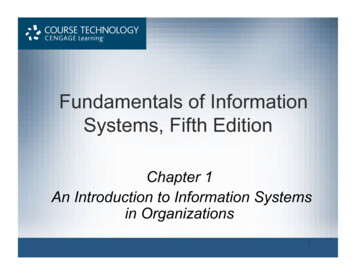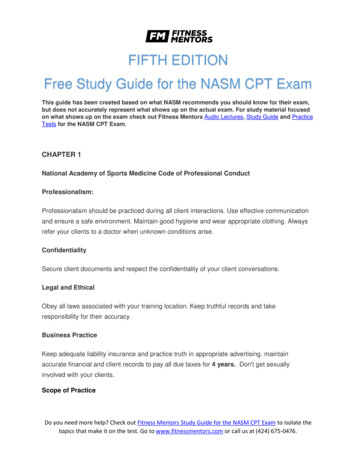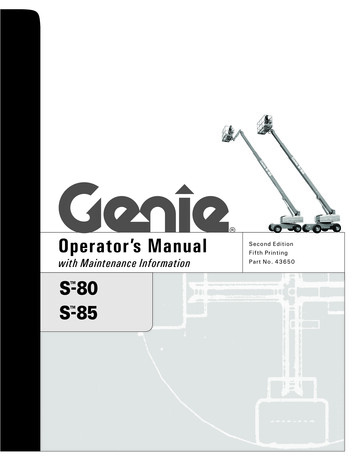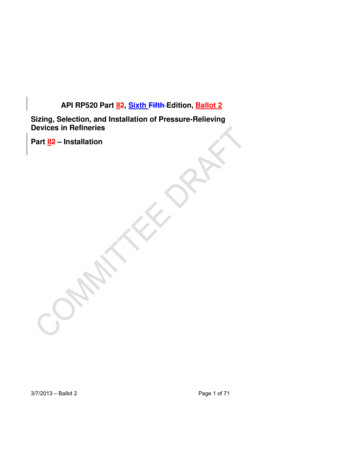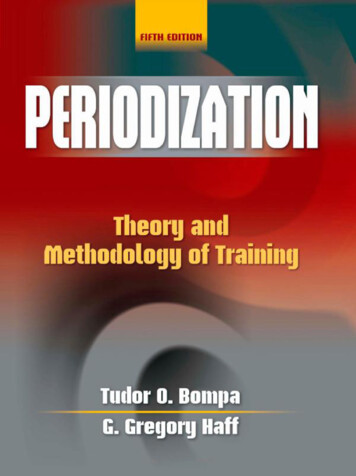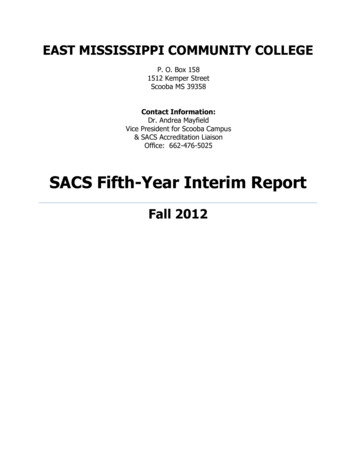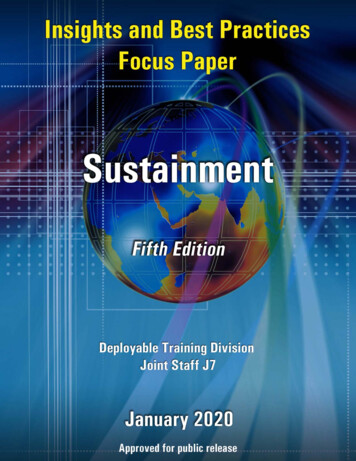
Transcription
This is the Fifth Edition of the Sustainment Insights and Best Practices Focus Paper. It iswritten by the Deployable Training Division (DTD) of the Joint Staff J7 and released by the J7Deputy Director for Joint Training.Fifth EditionFourth Edition:Third Edition:Second Edition:First Edition:January 2020May 2018May 2016December 2013June 2011Scope: Defines sustainment and the roles and responsibilities of key players in the planning andexecution of sustainment functions at the theater-strategic and operational levels. Addresses developing a concept of support at the operational level to set the foundation forintegration of the various sustainment functions. Introduces the sustainment sub-functions and offers insights and best practices for achievingsustainment goals.Table of Contents1.0 Executive Summary . 12.0 Globally Integrated Sustainment . 23.0 Enabling Sustainment . 44.0 Sustaining Operations . 6Glossary: Abbreviations and Acronyms . GLTerminology and Acronyms: Numerous military acronyms and organizational names are usedin this paper. They are defined in the glossary (not in the body of the paper) to improvereadability in the body of the paper.POC: js.dsc.j7.mbx.joint-training@mail.milDeployable Training Division, Deputy Director Joint Staff J7, Joint Training116 Lake View Parkway, Suffolk, VA 23435-2697Accessibility: This and other insights and best practices papers can be accessed on the internet atthe Joint Electronic Library site: http://www.jcs.mil/Doctrine/focus papers.aspx.Disclaimer: The views in this paper are those of the author and do not necessarily reflect theofficial policy or position of the Joint Staff, the Department of Defense (DOD), or the UnitedStates Government (USG).Releasability: Approved for public release.
PREFACEThis paper addresses integration of sustainment functions to enable mission accomplishmentwhile retaining agility and adaptability to respond to the uncertainties of a dynamic world. Wecapture these insights and best practices from joint headquarters planning and conduct ofoperations.This paper focuses on three primary audiences: CCMD and JTF Chiefs of Staff as they consider how to synchronize sustainment. CCMD and JTF-level operational planning team (OPT) members. Members of a Sustainment Team who are developing or executing the concept of support.Four considerations: Involve the commander early. Maintain an anticipatory and inclusive staff mindset to set the theater conditions and achievelong-term force sustainment. Understand global resource limitations and time-distance requirements to set conditions forsuccesses as resources are prioritized and usage is coordinated.Include sustainment functions (logistics, engineering, health services (HS), personnelsupport, operational contract support (OCS), and religious ministry support in CombatantCommand Campaign Plans (CCP).This and other focus papers share observations and insights on Joint Force HQs observed by theJoint Staff J7 Deployable Training Division. The DTD gains insights on operational mattersthrough regular contact and dialogue with Combatant Command and operational-levelcommanders and staffs as they plan, prepare for, and conduct operations and exercises. The DTDincorporates these insights in functionally based focus papers which are then refined throughsenior flag officer feedback. The papers are then shared with the Joint Force and the joint lessonslearned, joint doctrine, and future concepts communities. These papers are found on the sitenoted on the inside front cover.Please send your thoughts, solutions, and best practices to DTD’s POC, Mr. Mike Findlay, asyou think, plan, and work your way through these challenges. See inside the front cover for POCcontact information.i
This page intentionally left blank
1.0 EXECUTIVE SUMMARY. This paper shares emerging joint sustainment insights and bestpractices across the range of military operations. The paper addresses joint HQ sustainmentactivities at the theater-strategic (CCMD) and operational (JTF) levels in the areas of logistics,engineering, HS, personnel support, operational contract support (OCS), and religious ministrysupport.Sustainment is one of eight warfighting functions common to joint operations and encompassesthe provision of logistics and personnel services to maintain and prolong operations up to andincluding mission accomplishment and redeployment of the force. Sustainment consists of allcore logistics capabilities (including supply, maintenance, deployment and distribution, HS,logistics services, engineering, and OCS) along with personnel support services such as humanresources, financial management, and religious ministry.This paper is based on observed insights and best practices and is consistent with the 2018National Military Strategy (NMS) and the 2015 Joint Concept for Logistics as they pertain to theconcepts of global agility and globally integrated operations. Sustaining operations in atransregional, all domains multifunctional environment highlights the challenges for the militaryto aggregate, operate, and disaggregate rapidly—the hallmarks of globally integrated operations.Critical access to the global commons, air and seaports—once taken for granted—could verywell be contested. Cyber vulnerabilities of a sustainment network operating in a largelyunclassified domain with other government and commercial partners will continue to challengesustainment planners across the enterprise. Additionally, cross-CCMD conflicts will requiretimely adjudication of limited resources. Put simply, the current operating environment providescomplex challenges to sustaining global operations.Key Challenges: Anticipating requirements in an uncertain, complex, and rapidly changing operatingenvironment. Leveraging global providers that are part of the Joint Logistics Enterprise (JLEnt) to ensurerapid and precise response for the Joint Force Commander (JFC). Integrating sustainment capabilities to support joint force and partner requirements.Key Insights: The involvement of the commander and the staff’s ability to anticipate requirements andleverage available capabilities are crucial to setting theater conditions and successful longterm force sustainment. Time-distance requirements and limited availability of global resources can become factorsearly in a conflict or crisis. Coordinate and prioritize critical resources to help set conditionsfor success. Include sustainment functions (logistics, engineer activities, HS, and personnel support) inCCP objectives. Projecting and tracking force flow informs operational decisions on available jointcapabilities and necessary force allocation/reallocation.This Insights and Best Practices paper begins with a section on globally integrated sustainment,focusing on strategic level partners and associated insights. The following sections focus onenabling sustainment and sustaining operations.1
2.0 GLOBALLY INTEGRATED SUSTAINMENT. Today’s complex joint operatingenvironment places a significant burden on strategic and operational level sustainment partnersto ensure the DOD’s ability to conduct multiple, simultaneous (or near simultaneous) operationsaround the world. The Chairman’s priority challenges, coupled with the transregional,multifunctional, and all-domain aspects of the operating environment, requires a solidunderstanding of global sustainment requirements and the ability to adjudicate the distribution offinite resources.Sustainment Defined (JP 4-0). Jointsustainment is more than logistics. The jointlogistics capabilities, along with thepersonnel support capabilities in thediagram, are integral parts of sustainmentand vital for supporting, operations, andcontingencies.The responsibility for these capabilities istypically spread across multiple staffdirectorates and special staff sections (e.g.,J1, J4, J7, J8, Surgeon, and Chaplain). Tofurther complicate matters, not all joint forcecommands are organized exactly alike. For example, the joint HQ Surgeon section could beorganized under the J4 or be part of the commander’s special staff. The staff engineer may beorganized under the J3, the J4, or as a special staff section. This variation can make theintegration of capabilities more challenging, both vertically (HQ to components), andhorizontally (HQ to HQ). Each functional area provides a unique view of supporting operations;success entails effective synchronization of these capabilities to support the mission.Joint Concept for Logistics (JCL). In 2015, the Vice Chairman of the Joint Chiefs of Staffsigned the Joint Concept for Logistics. The central theme of this document is the concept ofGlobally Integrated Logistics (GIL) as a major underpinning of Globally Integrated Operations(GIO). The concept of GIL relies on an adequately resourced JLEnt, a robust transportation andcommunications/data network, and “leaner forces and operations.” The JCL outlines 24 requiredcapabilities critical to enabling globally integrated logistics, from increased forward basing andprepositioning of materiel to an increased ability to conduct logistics-over-the-shore operationsin a contested environment. Additionally, the JCL highlights seven significant risks to achievingGIL while providing notional mitigation strategies. While not a prescriptive document, the JCLis a must-read for all joint sustainers as the future operating environment will require adaptive,critical thinking to develop new and agile ways to support globally integrated operations.Understanding the JLEnt. GIO requires coordinating and partnering with multiple globallogistics providers, both military and civilian. The sustainment and logistics demands resultingfrom complex emergencies (both kinetic and non-kinetic) require an “enterprise” approach sinceemergencies often transcend the ability of a single nation, government, or organization to addressalone. The joint force’s ability to succeed requires this cross-matrixed, multi-tiered network ofkey global providers to work cooperatively to achieve a common purpose without jeopardizingtheir own mission and goals.2
Effective situationalawareness is gained byunderstanding stakeholderobjectives, authorities,goals, and limitations in anoperation. This situationalawareness can enablesustainment planners toidentify potential supportopportunities as well aspotential resource conflicts.Interagency andmultinational partners mayplay key or lead roles inFHA/DR or DSCAmissions while the JointForce remains in support.Significant effort may berequired in communicating joint force capabilities to involved stakeholders and partners due tosystem interoperability gaps.Leveraging National Level Sustainment Providers. Sustaining GIO with limited resourcesrequires a robust and agile non-organic vendor base. Combat Support Agencies (CSA) such asDLA provide added capabilities to the Joint Force Commander through extensive commodityand services networks. Joint sustainers should include both CSA inputs and commercial industryconsiderations into planning efforts early to identify any gaps, seams, or shortfalls. The ability ofthe commercial industry base to flex production to meet emergent demands remains a necessity.However, cost, production schedules, and transportation requirements are all variables that affectthe ability of industry to meet emerging requirements. The Joint Staff J4, on behalf of theCCDRs, partners with OSD to influence commercial entities to meet mission needs (e.g.,munitions, strategic lift).Insights: The broader community of JLEnt stakeholders may have capabilities and resources that canbe leveraged (e.g., local knowledge, established connections, etc.). Build relationships andtrust with relevant JLEnt partners before a specific crisis. Understand JLEnt partnersauthorities, goals, and limitations. During a crisis, involve JLEnt partners early in the planning process; this may provideadditional capabilities and capacities. Be prepared to provide support to other USG agencies, IGOs, coalition members, NGOs, andPVOs.3
3.0 ENABLING SUSTAINMENT.Sustainment Team Concept. The Sustainment TeamConcept is a philosophy more than a hard and fast setof business rules.Fostering a Sustainment Team mindset on the staffenhances planning and coordination across theSustainment staff sections (e.g., J1, J4, J8, Surgeon,and Chaplain).Sustainment Team organization should be tailored tobest support each mission. The key take away is thatSustainment staff sections routinely coordinate atboth the senior leader and action officer level, toaddress issues to support the mission.Organization of Sustainment functions at the CCMD level varies. Although the Engineer andSurgeon staff sections may be consolidated in the J4, they are frequently organized as a specialstaff section or in a different J-code.The Sustainment Team Concept is employed through deliberate internal staff synchronizationmeetings between the various directorates. Whether formal or informal, there are clear benefitsin a Sustainment Team to include: Better synchronizes and coordinates overlapping Sustainment functions.Provides consistent cross-functional inputs supporting operational planning and execution.Facilitates information sharing while minimizing stove-piped efforts.Develops a comprehensive picture of Sustainment issues.Insights: Operating as a Sustainment Team can promote comprehensive planning and concept ofsupport development. During a contingency, a Sustainment Team approach can help synchronize crossfunctional/directorate requirements such as personnel rotation, , resourcing, mortuary affairs,casualty tracking and patient evacuation, transportation and lift, and KLE requirements.Sustainment support, particularly when operating in remote or austere locations, oftenrequires significant lead time. Including the Sustainment Team up front and early in thedesign and planning phase enables them to anticipate requirements and help set conditionsfor mission success.Best Practices: Include representatives from the J1, J8, Engineer, Chaplain, and Surgeon staff sections inSustainment battle rhythm events to facilitate senior-level synchronization of sustainmentefforts. Include other J-code directorate representatives in the JLCB, for example: J2 briefs status oflines of communication (LOC); Cyberspace representatives briefs vulnerabilities of logisticssystems; J3 representative ensures operational priorities are communicated and understoodby the Sustainment Team; and interagency representative provides situational awareness oncivil-military operations.4
Informing the Commander’s Decision Cycle. Synchronizing and integrating sustainment staffefforts are not only important to ensure unity of effort and economy of staff, but ultimately tobetter inform the Commander’s decision cycle. The sustainment team provides advice andrecommendations to the commander concerning prioritization and allocation of support.Therefore, the sustainment team must have a clear understanding of the commander’s intent andCONOPS and be able to anticipate the basic mobilization, deployment, employment, andsustainment requirements of the plan. The sustainment team best supports the Commander’sdecision making process through integration into the command’s battle rhythm across all threeevent horizons—CUOPs, FUOPs, and FUPLANs. The sustainment team integrates capabilitieswith operations and commander’s decision cycle activities (i.e., Design and Plan, Direct,Monitor, and Assess). Sustainment planners and functional SMEs should stay engaged as plansand planning products are developed and refined.The Joint Logistics Operations Center (JLOC)and Joint Deployment and DistributionOperations Center (JDDOC) are the fusioncenters for logistics execution efforts on thestaff and must stay closely connected to the JOCas plans transition to execution. The sustainmentteam establishes functional B2C2WGs andrepresents sustainment equities in othercommand battle rhythm events. The JLCB(coordination board) is the primary logisticsboard for overall theater logisticssynchronization. Other supporting boardsinclude the Joint Movement Board (JMB) fortheater lift prioritization and allocation, the JCMEB for civil-military construction projects andresources, and the JRRB (for requirements) and CLPSB (for procurement) for theater contractsupport coordination. The sustainment staff has representation in the JOC and other B2C2WGsto provide staff estimates and supportability analyses throughout planning and execution.The Sustainment Team also supports the command’s assessment process which informs futuredesign and planning. Sustainment planners and functional SMEs determine measures ofeffectiveness based on the concept of support to monitor and assess progress and effectiveness.Insight: Synchronize sustainment staff efforts across all event horizons to inform decision-making.Best Practices: Include the correct sustainment SMEs in appropriate command B2C2WGs (e.g., JointTargeting Working Group/Board, Interagency Working Group, KLE Working Group, JointEffects or Assessments Working Group/Board, etc.) to ensure staff products and analysisincorporate sustainment considerations from the beginning. Prepare back-brief charts/notes from command B2C2WGs to JLOC/JLCB for staffawareness. Establish Directorate Critical Information Requirements (DCIRs) to prioritize staff effortssupporting sustainment decision making. Develop MOEs in coordination with the J3/5, components, and subordinates and participatein the assessment process to ensure support adaptation based on assessment of LOOs/LOEs.5
4.0 SUSTAINING OPERATIONS.Logistics. Joint logistics is the coordinated use, synchronization, and sharing of two or moremilitary departments’ logistics resources to support the joint force. The JLEnt projects andsustains a logistically ready joint force by leveraging DOD, interagency, nongovernmentalagencies, multinational, and industrial resources. The identification of established coordinationframeworks, agreements, and other connections create an efficient and effective logisticsnetwork to support the mission.Over the last four decades, there were few adversaries capable of contesting our logisticsnetwork. Logistics and our strategic agility were our comparative/competitive advantages.However, today’s peer or near peer adversaries increase the challenge to logistics, theaterconsiderations, engineering, health services, and personnel support. This introduces newchallenges and emerging vulnerabilities that we will need to protect. This all must be more fullyconsidered in today’s plans.Setting the Theater. At the theater level, coordination across components and subordinates iscrucial to set the theater and ensure long-term sustainment. Subordinates and components workwith the CCMD staff to assess capabilities, limitations, and resources early in the planningprocess. Directive Authority for Logistics(DAFL). Authority, in its simplestform, can be characterized as thepower to perform some act or takesome action. “Authority” is not adoctrinal term and is oftencharacterized as a permission. Thereare many challenges andcomplications concerning authoritiesthat impact logistical support.CCDRs exercise DAFL as part of CCMD authority to organize logistics within the theateraccording to operational needs. DAFL includes the authority to issue directives tosubordinate commanders, including peacetime measures necessary to ensure effectiveexecution of OPLANs, effectiveness and economy of operation, and prevention orelimination of unnecessary duplication of facilities and functions overlapping among Servicecomponent commands. DAFL does not alleviate Service responsibility for logistics support,discourage coordination by consultation and agreement, disrupt effective procedures, orprevent efficient use of facilities or organizations. Unless otherwise directed by the Secretaryof Defense, the military departments and Services continue to have responsibility forlogistics support of assigned forces attached to joint commands. The CCDR may delegateDAFL for common support capabilities to a subordinate JFC as required to accomplish theassigned mission. When delegated to a subordinate commander, the CCDR formallydelineates this delegated authority by function and scope to the subordinate JFC. Agreements. Agreements reduce the logistical and financial burden on the force. Acquisitionand Cross-Servicing Agreements (ACSA) and Inter-Service Support Agreements (ISSA) aretwo of the many agreements that directly impact logistics efforts. ACSAs allow the United6
States allies and coalition partners to exchange food, fuel, transportation, ammunition, andequipment with U.S. forces and does not commit any participating country to military action.An ISSA allows support between DOD agencies. Enablers. Joint Logistics-Over-The-Shore (JLOTS) and USTRANSCOM’s JTF-PortOpening (JTF-PO) support logistics efforts by providing the ability to move materiel with orwithout a fixed port of debarkation (POD). JLOTS gives JTFs the ability in contested ordenied environments to load and unload ships in unimproved areas where ports are damaged,unavailable, and/or without fixed facilities. Similarly, JTF-PO is a capability to rapidlyestablish and initially operate an aerial or seaport of debarkation in support of operations. Reception Staging Onward Movement and Integration. Our current and future jointoperating environment requires the ability to deploy and aggregate rapidly. RSOI is thetransitioning of deploying personnel and equipment into forces that are postured to supportoperations. Conflicts with peer or near peer adversaries increase vulnerabilities during RSOI. Distribution. Access, basing, and overflight authorization significantly impact distribution ofsupport. Redundancy in logistics support minimizes the impact and should be presented earlyin the planning process. Additionally, having global visibility of the sustainment picturelimits interruption to logistics support.Insights: Synchronize the sustainment staff efforts to enable unity of effort and economy of staff. Leverage the JLEnt in the CCDR’s Theater Logistics Concept. Scale sustainment capabilities across the phases of an operation and ensure each phaseachieves a fully collaborative information sharing (vertically and horizontally) environment. JLEnt partners will not always be able to share information due to incompatibility with DODnetworks. TPFDD planning is critical in balancing and prioritizing combat forces and combat servicesupport forces.Best Practices: Sequence critical enablers such as theater opening and force protection capabilitiesappropriately in the force flow. Recognize and tailor logistics posture activities to send coherent messages and to prevent aninadvertent escalatory message through what may be perceived as an aggressive logisticsposture. Develop running sustainment estimates to quantify requirements. If a legitimate government exists and there is sufficient time to negotiate an agreement,implement host nation support (HNS) under an umbrella MOU. In cases where an HNS agreement is not practical, resources may still be obtained locally.Local contracts can be made between the joint or multinational force and individual civilianproviders rather than at the national government level.Operational Contract Support. OCS is a critical capability that supports the Joint ForceCommander in a myriad of ways. Contracted support can provide the warfighter additionalflexibility in organic versus non-organic force mix decisions. Detailed planning that leveragescommercial capabilities can result in faster combat power build-up in the JOA as contracted7
support may be in place faster and with more capacity than equivalent military units. OCSextends the Joint Force Commander’s operational reach by deploying uniformed forces wheremost needed and contractors where best suited in support of operations. For example, contractorscan perform “inside the wire” tasks so troops can perform “outside the wire,” filling criticalcapability gaps such as linguists, well-drilling, etc. OCS can support diplomatic and economiclines of effort (LOEs) by employing local nationals and infusing money into the Host Nation(HN) economy. The following are considerations when planning for OCS: Force Manning Levels (FMLs). OCS supports the Joint Force Commander by attaining /maintaining economy of force missions/FMLs, facilitating unit off-ramps, and preventingrepetitive logistics/engineering unit deployments. Contract fratricide. OCS reduces military and OGO / NGO friction or competition byadjudicating competition over scarce resources. Unintended consequences. Poorly executed OCS can increase risk to mission and force byinadvertently funding the enemy with contract dollars, hiring contractors vulnerable to cyberthreats, who fail to or are unable to perform, or failing to manage requirements to ensure theyremain synchronized with operational needs. Poorly defined and managed requirementsresult in overspending and misuse of limited resources. Lack of oversight creates opportunityfor corruption or misbehavior.Insights: The joint force Operational Contract Support Integration Cell (OCSIC) works with financeand legal staff and theater support contracting activities to develop a requirements flowprocess, manage expectations for commercial support, convey joint force commanderpriorities, de-conflict OCS issues, and determine existing contracts or task orders that couldbe used to support operations. Service component/JTF staffs may not have permanent, fulltime OCS personnel. In order to establish an OCSIC, units may request augmentation fromservices or enabling organizations (i.e., DLA J32 Joint Contingency Acquisition SupportOffice (JCASO) or Defense Contract Management Agency (DCMA).The OCSIC ensures vertical and horizontal information flow with all directorates across allevent horizons. The information management (IM) plan is critical to efficient and successfulOCSIC operations. Establish the OCSIC portal as the singular IM hub for both staff andoutside organizations to post and download information. Post all OCS current and futureoperations, applicable FRAGOs, RFIs, subordinate requirements, contracting officerrepresentative (COR) information, analysis of operational environment information, etc. A clear awareness and understanding of the requirements flow process, types of fundssupporting the operation, and contents of a complete and acquisition-ready requirementspackage is paramount. Operationally critical support is supplies or services designated by the Government as criticalfor airlift, sealift, intermodal transportation services, or logistical support that is essential tothe mobilization, deployment, or sustainment of the joint force in a contingency operation.Many of these supplies and services are provided by commercial vendors. The joint force isvulnerable to adversary offensive cyber capabilities in this domain. Cyber subject matterexperts (SME), unit security reps, operations security personnel, contracting officers (KOs),8
and required activity POCs collaborate to identify Covered Defense Information that will beviewed, transmitted, or stored during Statement of Work (SOW) execution. These sameSMEs determine if SOW execution provides operationally critical support.Non-organic support requirements are operational requirements that cannot be met throughthe U.S. supply system or accomplished with available troops. They can usually be met withHNS or commercial solutions. Annex P is Host Nation Support and Annex W is OCS perJoint Pub 5.0 Joint Planning. HNS is the civil and military assistance provided by a HN to theforces located in or transiting through that HN's territory. HNS will play a critical role infuture operations and efficient use of available HNS can greatly aid a tailored force packageand augment the deployed sustainment force structure. However, it is not always clear whatauthorities commanders at different levels have to make HN/commercial sourcing decisionsfor validated requirements. It is also not always clear to commanders whether they have theauthority to coordinate directly with HN or coalition military for support. Commandsrequired to staff non-organic requirements through other headquarters/organizations willexperience delayed HN or commercial support.OCS Working Groups (OCSWGs) inform the Joint Requirements Review Board (JRRB) atcomponent level and lower, Joint Logistics Board, Joint Logistics Coordination Board,Combatant Commander’s Logistics Procurement Support Board, Joint Contracting SupportBoard, and others. OCSICs must ensure the OCSWG is on the command’s battle rhythm, hasa charter/7-minute drill approved by the Chief of Staff, and appropriate people attend on aconsistent basis. At component level and below, subordinates use OCSWGs to pre-brief nonorganic (or commercial if the host nation/commercial sourcing decision has been made)requirements and status of phase OCS tasks. Commands that do not preview non-organicrequirements prior to the JRRB will waste precious primary staff officer time discussing therequirement need, scope, cost, etc., during the JRRB.Best Practices: Ensure commercial capabilities support the Commander’s needs by designating trainedCORs and personnel to perform contract support integration and contractor managementfunctions.OCSIC ensures appropriate contracts include FAR Clause 52-204-21, DFA
This is the Fifth Edition of the Sustainment Insights and Best Practices Focus Paper.It is written by the Deployable Training Division (DTD) of the Joint Staff J7 a

